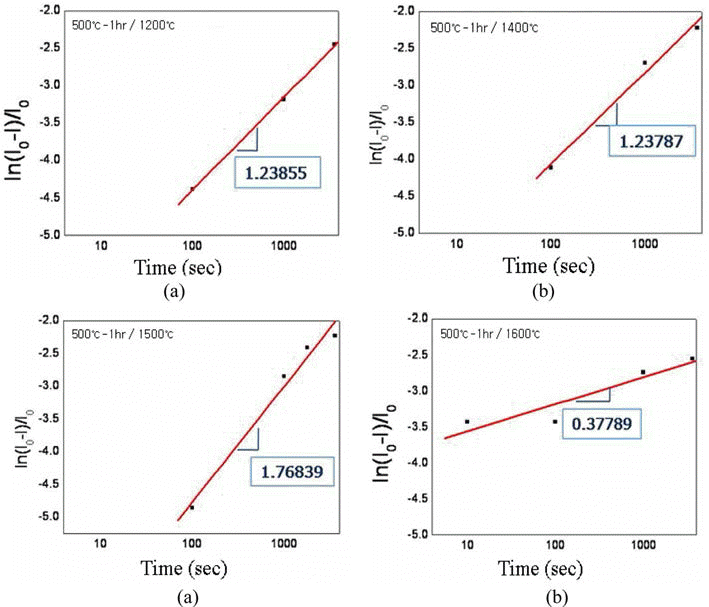Search
- Page Path
- HOME > Search
- [Korean]
- Effect of Oxygen Content in the Tungsten Powder Fabricated by Electrical Explosion of Wire Method on the Behavior of Spark-Plasma Sintering
- Cheol-Hee Kim, Seong Lee, Byung-Kee Kim, Ji Soon Kim
- J Korean Powder Metall Inst. 2014;21(6):447-453. Published online December 1, 2014
- DOI: https://doi.org/10.4150/KPMI.2014.21.6.447

- 480 View
- 1 Download
- 1 Citations
-
 Abstract
Abstract
 PDF
PDF Effect of oxygen content in the ultrafine tungsten powder fabricated by electrical explosion of wire method on the behvior of spark plasma sintering was investigated. The initial oxygen content of 6.5 wt% of as-fabricated tungsten powder was reduced to 2.3 and 0.7 wt% for the powders which were reduction-treated at 400°C for 2 hour and at 500°C for 1h in hydrogen atmosphere, respectively. The reduction-treated tungsten powders were spark-plasma sintered at 1200-1600°C for 100-3600 sec. with applied pressure of 50 MPa under vacuum of 0.133 Pa. Maximun sindered density of 97% relative density was obtained under the condition of 1600°C for 1h from the tungsten powder with 0.7 wt% oxygen. Sintering activation energy of 95.85 kJ/mol−1 was obtained, which is remarkably smaller than the reported ones of 380~460 kJ/mol−1 for pressureless sintering of micron-scale tungsten powders.
-
Citations
Citations to this article as recorded by- Effect of Powder Mixing Process on the Characteristics of Hybrid Structure Tungsten Powders with Nano-Micro Size
Na-Yeon Kwon, Young-Keun Jeong, Sung-Tag Oh
Journal of Korean Powder Metallurgy Institute.2017; 24(5): 384. CrossRef
- Effect of Powder Mixing Process on the Characteristics of Hybrid Structure Tungsten Powders with Nano-Micro Size
- [Korean]
- Synthesis and Characterization of WS2 Nanoparticles by Chemical Vapor Condensation
- Dong-Won Lee, Ju-Hyeong Kim, O. Tolochko, Jung-Yeul Yun, Byung-Kee Kim
- J Korean Powder Metall Inst. 2008;15(4):314-319.
- DOI: https://doi.org/10.4150/KPMI.2008.15.4.314

- 487 View
- 2 Download
-
 Abstract
Abstract
 PDF
PDF - Nano-sized tungsten disulfide (WS_2) powders were synthesized by chemical vapor condensation (CVC) process using tungsten carbonyl (W(CO)_6) as precursor and vaporized pure sulfur. Prior to the synthesis of tungsten disulfide nanoparticles, the pure tungsten nanoparticles were produced by same route to define the optimum synthesis parameters, which were then successfully applied to synthesize tungsten disulfide. The influence of experimental parameters on the phase and chemical composition as well as mean size of the particles for the produced pure tungsten and tungsten disulfide nanoparticles, were investigated.
- [Korean]
- Characteristics of L10 Ordered Fe50Pt50 Nanoparticles Synthesized by Chemical Vapor Condensation Process
- Gyeong-Mo Lee, Ji-Hun Yu, Dong-Won Lee, Byung-Kee Kim, Hyeok-Don Kim, Tae-Suk Jang
- J Korean Powder Metall Inst. 2007;14(5):281-286.
- DOI: https://doi.org/10.4150/KPMI.2007.14.5.281

- 432 View
- 1 Download
-
 Abstract
Abstract
 PDF
PDF - Ordered L1_0 to FePt nanoparticles are strong candidates for high density magnetic data storage media because the L1_0 phase FePt has a very high magnetocrystalline anisotropy (K_usim6.6-10times107erg/cm3), high coercivity and chemical stability. In this study, the ordered L1_0 FePt nanoparticles were successfully fabricated by chemical vapor condensation process without a post-annealing process which causes severe particle growth and agglomeration. The Fe_50Pt_50 nanopowder was obtained when the mixing ratio of Fe(acac) and Pt(arac) was 2.5 : 1. And the synthesized FePt nanoparticles were very fine and spherical shape with a narrow size distribution. The average particle size of the powder tended to increase from 5 nm to 10 nm with increasing reaction temperature from 800°C to 1000°C. Characterisitcs of FePt nanopowder were investigated in terms of process parameters and microstructures.
TOP
 KPMI
KPMI


 First
First Prev
Prev


